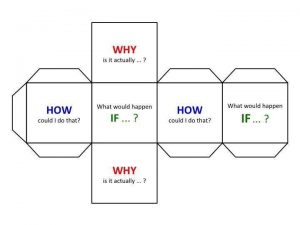Asking Smart Questions with the Question Game
. Posted in Parent-Child Advice, Teachers - 0 Comments
A four-year-old asks about 400 questions per day, and an adult hardly asks any. Our school system is structured around rewards for regurgitating the right answer, and not asking smart questions, and as we grow older, we stop asking questions. Yet asking smart questions is essential to find and develop solutions, and an important skill in innovation, strategy, and leadership. So why do we stop asking questions – and more importantly, why don’t we train each other, and our future leaders, to ask the right questions starting from early on?
Studies show there are three main questions which help in problem solving: Why questions, What If questions, and How questions. Why questions help to find the root of a problem, What If questions open up the floor for creative solutions, and How questions focus on developing practical solutions. Regardless of the question, each one needs to be phrased openly and positively in order to achieve positive results.

The Question Game focuses on teaching children a kind of thinking which is particularly useful in creative problem-solving. It provides a focused approach to get from a problem to the most effective solution. To prepare the Question Game for your classroom simply print out the figure in the illustration, cut it out, and glue the tabs together to form a cube.
 One simple idea is to pick up your favorite illustrated fairy tale book–the kind of book you’d read a two-year-old for bedtime stories. This also works with most fictional works; the natural ‘break point‘ for questions is at the end of a plot development or paragraph for older audiences. On each page, roll the cube and answer the question together. I’ll bet you’d be surprised by what turns the simple plot can take. And more importantly, after a while you and your child will both start asking smart questions reflexively.
One simple idea is to pick up your favorite illustrated fairy tale book–the kind of book you’d read a two-year-old for bedtime stories. This also works with most fictional works; the natural ‘break point‘ for questions is at the end of a plot development or paragraph for older audiences. On each page, roll the cube and answer the question together. I’ll bet you’d be surprised by what turns the simple plot can take. And more importantly, after a while you and your child will both start asking smart questions reflexively.
Here’s what to expect from children during the game:
1. Initial excitement: Rolling the cube puts the child in control and makes a fun addition to reading their picture books.
2. Distress: The questions are hard, especially when they aren’t used to this sort of thinking pattern and are accustomed to the adult knowing all the answers.
3. Acceptance: As the child starts to recognize that there isn’t a single correct answer and begins to understand what each question is trying to achieve, they begin to enjoy the game much more.
4. Application: You will start to notice changes in how the child goes about solving day-to-day problems during play. For example, let’s say a particular Lego construction doesn’t quite work, even though it was built according to instructions. The child may go about investigating what is wrong and fixing it by themselves, whereas before they may have immediately brought it to an adult for help.
Allison Green
Boston Tutoring Services
